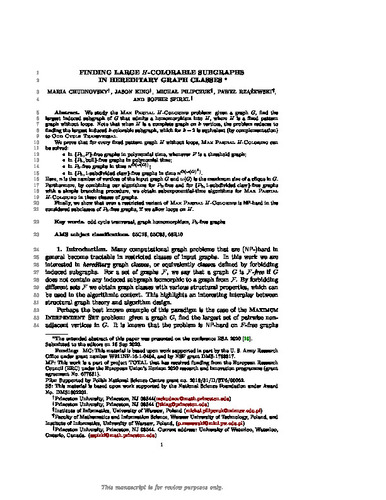| dc.contributor.author | Chudnovsky, Maria | |
| dc.contributor.author | King, Jason | |
| dc.contributor.author | Pilipczuk, Michał | |
| dc.contributor.author | Rzążewski, Paweł | |
| dc.contributor.author | Spirkl, Sophie | |
| dc.date.accessioned | 2022-08-22 14:07:57 (GMT) | |
| dc.date.available | 2022-08-22 14:07:57 (GMT) | |
| dc.date.issued | 2021-10-14 | |
| dc.identifier.uri | https://doi.org/10.1137/20M1367660 | |
| dc.identifier.uri | http://hdl.handle.net/10012/18591 | |
| dc.description | “First Published in SIAM Journal on Discrete Mathematics in 35, 4, 2021, published by the Society for Industrial and Applied Mathematics (SIAM)” and the copyright notice as stated in the article itself (e.g., “Copyright © by SIAM. Unauthorized reproduction of this article is prohibited.”') | en |
| dc.description.abstract | We study the Max Partial H-Coloring problem: given a graph G, find the largest induced subgraph of G that admits a homomorphism into H, where H is a fixed pattern graph without loops. Note that when H is a complete graph on k vertices, the problem reduces to finding the largest induced k-colorable subgraph, which for k=2 is equivalent (by complementation) to Odd Cycle Transversal. We prove that for every fixed pattern graph H without loops, Max Partial H-Coloring can be solved in {P5,F}-free graphs in polynomial time, whenever F is a threshold graph; in {P5,bull}-free graphs in polynomial time; in P5-free graphs in time nO(ω(G)); and in {P6,1−subdividedclaw}-free graphs in time nO(ω(G)3). Here, n is the number of vertices of the input graph G and ω(G) is the maximum size of a clique in G. Furthermore, by combining the mentioned algorithms for P5-free and for {P6,1−subdividedclaw}-free graphs with a simple branching procedure, we obtain subexponential-time algorithms for Max Partial H-Coloring in these classes of graphs. Finally, we show that even a restricted variant of Max Partial H-Coloring is NP-hard in the considered subclasses of P5-free graphs if we allow loops on H. | en |
| dc.description.sponsorship | The first author’s material is based upon work supported in part by the U.S. ArmyResearch Office under grant W911NF-16-1-0404 and by NSF grant DMS-1763817. The third author’swork is a part of project TOTAL that has received funding from the European Research Council(ERC) under the European Union’s Horizon 2020 research and innovation programme (grant 677651).The fourth author was supported by Polish National Science Centre grant 2018/31/D/ST6/00062.The fifth author’s material is based upon work supported by the National Science Foundation underaward DMS-1802201. | en |
| dc.language.iso | en | en |
| dc.publisher | Society for Industrial and Applied Mathematics | en |
| dc.subject | odd cycle transversal | en |
| dc.subject | graph homomorphism | en |
| dc.subject | P5-free graphs | en |
| dc.title | Finding Large H-Colorable Subgraphs in Hereditary Graph Classes | en |
| dc.type | Article | en |
| dcterms.bibliographicCitation | Chudnovsky, M., King, J., Pilipczuk, M., Rzaͅżewski, P., & Spirkl, S. (2021). Finding Large $H$-Colorable Subgraphs in Hereditary Graph Classes. SIAM Journal on Discrete Mathematics, 35(4), 2357–2386. https://doi.org/10.1137/20M1367660 | en |
| uws.contributor.affiliation1 | Faculty of Mathematics | en |
| uws.contributor.affiliation2 | Combinatorics and Optimization | en |
| uws.typeOfResource | Text | en |
| uws.peerReviewStatus | Reviewed | en |
| uws.scholarLevel | Faculty | en |

